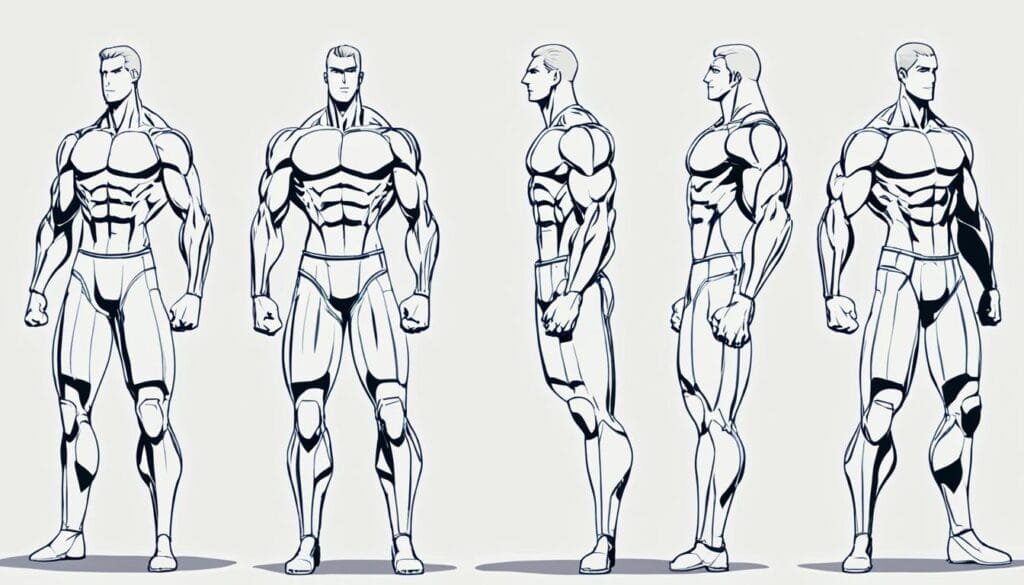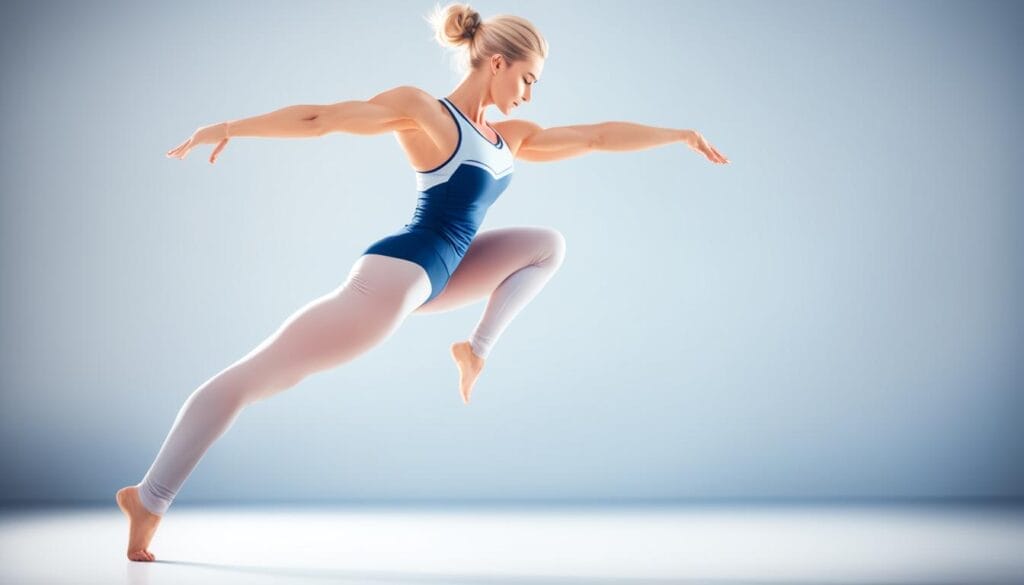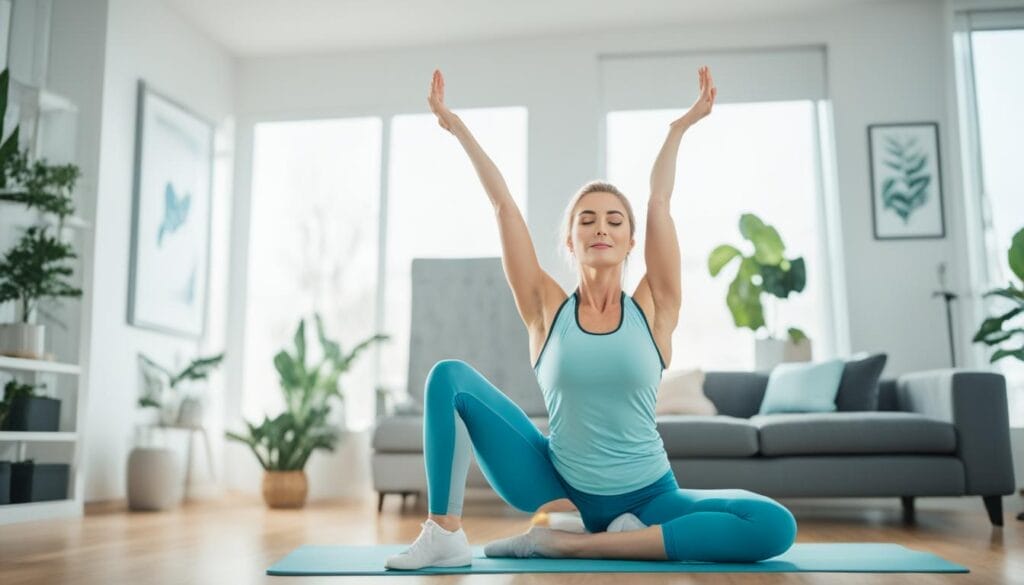Being flexible is very important for an athlete like me. When I first started in sports, I’ve always worked on being more flexible. It helps me move better, stay away from injuries, and stand out in my sport (martial arts).
It was hard sometimes. I remember feeling like I couldn’t do my best because of tight muscles. But, I soon learned how crucial flexibility for athletes is to keep my body flexible through regular training.
For any athlete wanting to boost their game, I want to offer some advice on being more flexible. These tips have been a big help for me and I think they could work for you too. They’re good whether you play at a high level or just want to get better at sports. You’ll get tips that are both useful and easy to follow to improve your flexibility.
Key Takeaways:
- Choose the right types of stretches based on your goals and needs
- Target the correct muscles for stretching
- Consider the CRAC method (Contract Relax, Antagonist Contract)
- Focus on enhancing movement control, muscle balance, and range of motion
- Consistently incorporate stretching into your exercise routine
The Best Types of Stretches for Your Body
Improving flexibility for athletes means choosing the right stretches for you. The type of stretch you do changes depending on what you want to achieve. There are two main types: dynamic and static stretches.
Dynamic Stretches: Mobilizing Before Activity
Dynamic stretches make your body parts move fully. They’re perfect before you exercise or play sport. These stretches get your muscles ready for movement and reduce injury risks. Movements like backward stepping lunges with a twist or arm swings are good examples. They use lots of muscles, making you more flexible and better at your sport.
Static Stretching: Addressing Postural Imbalances
Static stretching helps fix posture problems and makes your muscles more flexible. You hold a stretch without moving for a while, usually 15 to 60 seconds. This lets your muscles stretch and relax, getting more flexible. It’s great for easing muscle tightness from bad posture or doing the same movements a lot. And it makes your posture better.
Focusing on the muscles causing your posture problems is key for static stretches. For instance, sitting a lot makes your hip flexors tight and your glutes weak. Doing a stretch like the kneeling hip flexor stretch can help loosen up and fix your body’s balance.
Remember, both dynamic and static stretching are important for your flexibility routine. Using a mix of these stretches can boost your flexibility, make you better in sports, and fix your posture issues.
Identifying the Best Muscles to Stretch
Addressing pain from a wrong posture can be tricky. For instance, if you have rounded shoulders and an aching upper back, stretching chest and arm muscles might seem the obvious fix. But, the true issue might be short muscles in the opposite area, like the pecs. These tight muscles could be causing most of the pain, needing more focus than the stretched ones.
To really fix this, considering the whole muscle group is key. Target the tight muscles and balance them with their opposites. This way, you’re tackling the root problem, not just the pain. By doing so, you correct the imbalance and relieve the ache.
Understanding the Concept of Postural Imbalances
Postural imbalances happen when certain muscles get too tight while others get weak. This makes your body get into bad positions, causing pain and stiffness. To fix this, knowing which muscles are out of balance is crucial.
If you sit a lot, your hip flexors might tighten and the glutes weaken. Stretching the hip flexors and gluteal muscles can help. This restores your body’s balance and makes your posture better.

Stretching the Opposing Muscle Groups
In some cases, just stretching the sore muscles won’t help much. Take lower back pain, for example. Instead of only stretching the back, focus on the opposite muscles, like the hip flexors. Tight hip flexors can cause lower back pain.
Focusing on both short and long muscles is important. It lets you deal with the real issues. This not only keeps pain away but also makes you more flexible.
The CRAC Approach to Stretching
Improving flexibility has many methods, like the CRAC (Contract Relax, Antagonist Contract) method. Experts recommend this for its effectiveness. It uses Proprioceptive Neuromuscular Facilitation (PNF) to stretch specific muscles.
This method works in two main steps. Start by contracting the muscle you’re stretching. Hold this for a few seconds. Then, relax that muscle and contract the opposite muscle. Do this for a certain time.
Stretching the psoas muscle, found at the front hip, is a good example of CRAC. Begin with the hip flexors in a stretch. Then contract them for three seconds. Relax and change to contracting the glute max for 10 seconds.
This not just stretches the short muscle. It also activates the less used one. This brings balance and boosts overall flexibility.
The CRAC way is great because it mixes stretching with muscle contractions. This mix boosts your muscle’s length and flexibility. It also betters muscle balance and control. Doing CRAC in your stretches targets specific muscles, getting you more flexible.
For flexibility for athletes and those wanting more flexibility, CRAC is a win. But remember, doing these stretches right is crucial to stay safe. Getting advice from a fitness pro or therapist ensures you do it properly.
The Benefits of Stretching for Athletes
Stretching is not just about getting flexible. It helps with movement control, muscle balance, and knowing your body’s position (proprioception). This makes it a key part of being an athlete.
By stretching, you improve how aware your body is of its movement. This is called proprioception. It means you can move better and with more balance. This leads to better sports performance and less chance of getting hurt.
“Stretching helps me tune in to my body’s movements and allows me to perform with better control and coordination. It’s like fine-tuning a musical instrument; stretching helps me find my rhythm on the field,” says professional footballer Sarah Miller.
Stretching also helps when your muscles are not balanced. Athletes can get uneven muscles because of their sport. Stretching makes tight muscles looser and wakes up muscles that aren’t used much. This helps all your muscles work better together. It also makes your training with weights more effective.
Some experts are still looking into how stretching prevents injuries. But a lot of athletes and coaches think stretching does reduce injury risk. It makes your muscles looser. This can stop you from getting sudden muscle injuries. So, stretching can keep you playing your sports without a break.
“Stretching has been a game-changer for me in terms of injury prevention. Since I started a dedicated stretching regimen, I’ve noticed a significant decrease in muscle pulls and strains. It’s an essential part of my training routine now,” shares endurance runner Mark Johnson.
Summing up, stretching does a lot for athletes. It helps with how you move, keeps your muscles balanced, and makes you more aware of your body. This all means you can sport better and safer. So, don’t skip the stretch before your game or practice. Make it a must-do for using all your sport skills right.

Incorporating Stretching into Your Routine
To get more flexible and enjoy stretching benefits, put it in your usual exercise time. You can do this in many ways. This includes doing stretches before and after workouts, having separate times just for stretching, and doing exercises to help you move better.

Pre- and post-workout stretching: Stretching before you start working out gets your muscles ready. It also makes you more flexible. After you work out, your muscles are warm. Stretching then helps you do deeper stretches.
Dedicated stretch sessions: Make time just for stretching. This helps your posture and makes you more aware of how your joints move. It balances your muscles and makes your movements more accurate.
Mobility workouts: Include stretching and more movement in your warm-up and cool-down. It does wonders for your flexibility. You can focus on different parts of your body and make your joints move better.
Find a stretching plan that you like and keep at it. This could mean a bit of stretching before and after you exercise. Or you might choose to have a few days just for stretching. Doing this will improve your flexibility and your overall health.
Tips for Building Flexibility
To build flexibility, listen to your body and work on tight spots. Knowing your less flexible areas helps focus your efforts.
It’s key to keep a good posture. Wrong posture tightens your muscles. Sit straight with shoulders back and spine in line.
Sitting on the floor in various positions can stretch you well. Positions like cross-legged or kneeling can stretch the hips and spine. Use the floor for a better stable stretch.
Adding flexibility exercises to your workout boosts your overall flexibility. Activities like stretching or yoga improve how your joints move.
Daily stretching is crucial for getting more flexible. Spend a few minutes stretching your tight muscles. Hold each stretch for 30 seconds to let the muscle relax.
By focusing on your body, keeping good posture, and regular exercises, you can get more flexible. Make these tips part of your daily routine. It’s the best way to see continuous improvement in your flexibility.

Summing Up Flexibility For Athletes
Flexibility training is key for better sports performance and lessening the chance of getting hurt. By doing the correct stretches and exercises, you can enhance how you move, balance your muscles, and feel your body in space. While experts still look into how stretching can prevent injuries, many say it does help. Choosing the best stretches means looking at what you want and need.
Listen to your body and keep your posture right when stretching. It’s vital to do this often as part of your fitness plan. Keep at it, and you’ll see your sports abilities grow with improved flexibility.
FAQ
How can I improve flexibility as an athlete?
As an athlete, adding stretching to your routine is key for flexibility. For warm-ups, try dynamic stretches to get muscles moving. After exercise, include static stretches to counteract any imbalances and keep your posture in check. Choosing the right stretches for your needs is crucial.
How do I know which muscles to stretch?
Finding which muscles to stretch can be tricky, especially for persistent pain. Look at which muscles oppose each other. Stretching the right ones will help balance your body and ease discomfort.
What is the CRAC approach to stretching?
The CRAC method, also called PNF stretching, is where you stretch a tight muscle and then contract its opposite. This approach improves muscle length and balance, boosting flexibility.
What are the benefits of stretching for athletes?
Stretching enhances an athlete’s control over movement and muscle balance. Research on its direct role in injury prevention is ongoing. However, many believe it can cut down on injuries. Plus, flexibility can help you move smoother and control your muscles better.
How can I incorporate stretching into my routine?
To add stretching to your routine, warm up and cool down with it. Stretch more deeply when your muscles are warm, like after your exercise. Also, focus sometimes on releasing any posture strains and becoming more aware of your body’s joints.
Integrating stretching and movements for flexibility in your before and after workout plans can help. This inclusion will make you more supple overall.
What are some tips for building flexibility?
Improving flexibility involves listening to your body and working on any tight spots consistently. How you sit, stand, and move every day can either help or hinder your flexibility. So, aim to sit on the floor in varied ways to challenge and stretch your body.
Make flexibility training part of your regular exercise. This can be through stretching, yoga, or any other type of movement. Remember, the key is to do a little bit each day to get more flexible.
Can flexibility training help prevent injuries?
Stretching and injury prevention are still being understood by science. Yet, many people find that regular stretching reduces their injury risk. Moreover, it can make your resistance training more effective by balancing your muscles.
Source Links
Share Me:
READY TO UNLEASH
YOUR BEST SELF?
Click “Sign Me Up!” And Start Your Fitness Transformation!





